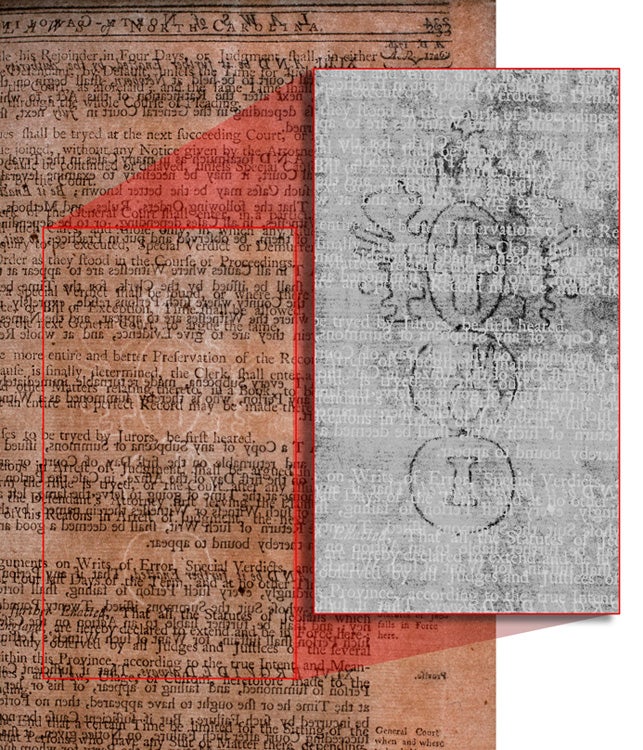Colonial North Carolina’s Pirate Paper
Source:
A Collection of all the Public Acts of Assembly, of the Province of North Carolina (New Bern: J.Davis, 1752).
Joyner Library Special Collections, North Carolina KFN7430 1752 .A2
Digitized version available online in Joyner Library’s Digital Collections.
Staff Person: Lawrence Houston
Description:
In 1749, James Davis was hired by the colonial government to be the colony’s first printer. He was authorized to print currency and the laws of the North Carolina Assembly near the capitol in New Bern. He started out by acquiring an old set of lead type and a printing press from colleagues in Williamsburg, Virginia. He also purchased several reams of paper from Benjamin Franklin. However, paper in the colonies was not cheap or easy to come by.
Because of the high tariffs and duties on imported paper, the only reasonably costed supplies came from either Great Britain or from one of about a dozen paper mills operating colonies. The discarded pieces of white cotton or linen cloth that formed the raw material for paper were always in short supply. Despite receiving a fixed stipend from the colonial government, Davis was still confronted with thin profit margins and low sales volume from his printing venture. He did many things to turn a higher profit from his business—including trafficking with pirates to get cheaper paper.
In the 1740’s, the British government was involved in a series of conflicts over claims to the Habsburg monarchs’ territory in Austria. During one of these conflicts, the War of Jenkin’s Ear, the British acted against their Spanish and Genoese adversaries by appointing privateers—pirates who were legally commissioned by the government to raid the merchant vessels of their enemies. By 1747, British privateers had delivered over £140,000 of Genoese spoils to colonial ports, like New York and New Bern. This booty included numerous bales of paper, which the privateers sold cheaply to colonial printers such as Benjamin Franklin and James Davis.
Our copy of A Collection of all the Public Acts of Assembly, of the Province of North Carolina was one of the first law books printed by Davis. In this book, alongside paper likely purchased from a mill in Virginia, he used a few sheets of Genoese paper obtained by British privateers. Owing to the difficulty in getting regular supplies of paper, there are over a dozen different sources for the paper used in this book alone.

Watermark from pgs 233-234 of the Acts of Assembly viewed with transmitted light, depicting the Coat of Arms for the City of Genoa.
We can determine the origin of the paper in this book by looking at the watermark. Watermarks, thinner areas in the paper sheet, are created from wires laid onto the papermaking moulds. One can see watermarks when light is shined through the paper. Papermakers utilized watermarks to distinguish their product from that of competitors and to differentiate one stock of paper from another. The watermark on this page bears the coat of arms for Genoa: a cross flanked by griffons. The additional markings seen in the two lower circles vary greatly in Genoese papers and can correlate to specific paper makers or dates of manufacture.
Citations & Sources:
- Amory, Hugh & Hall, David., eds. A History of the Book in America, Volume 1: The Colonial Book in the Atlantic World. University of North Carolina Press, Chapel Hill. 1997.
- Balmaceda, Jose Carlos. “Genoa’s Contribution to the Development of the Spanish Paper Manufacture” in Paper as a Medium of Cultural Heritage. Instituto Centrale per la Patologia del Libro, Rome. 2004.
- Heawood, Edward. Watermarks, mainly of the 17th and 18th centuries. Paper Publications Society, Hilversum, Holland. 1950.
- McMurtrie, Douglas C. “First Twelve Years of Printing in North Carolina, 1749-1760.” North Carolina Historical Review 10. July, 1933.
- Houston, Lawrence. Unpublished MLIS Master’s Thesis. 2017.
- Gravell, Thomas. American Watermarks, 1690-1835. Oak Knoll Press, New Castle, Deleware. 2002.